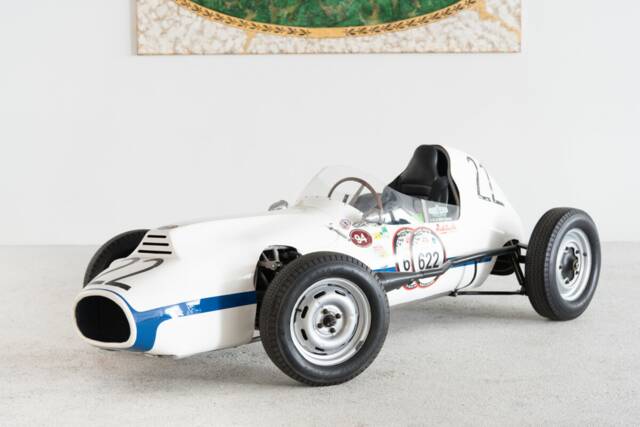DKW Formula Junior classic cars for sale
The DKW Formula Junior stands out among historic race cars as a symbol of German motorsports engineering from the late 1950s and early 1960s, combining lightweight construction, innovative two-stroke powertrains, and a racing pedigree rooted in the golden era of Formula Junior competitions.
Search results

1960 | DKW Formula Junior
DKW Mitter Formula Junior
DKW Formula Junior listing references from Classic Trader
Below you will find listings related to your search that are no longer available on Classic Trader. Use this information to gain insight into availability, value trends, and current pricing for a "DKW Formula Junior" to make a more informed purchasing decision.

1959 | DKW Formula Junior
Formel Junior
History of the DKW Formula Junior
Developed as DKW’s entry into the international Formula Junior racing scene, the Formula Junior models emerged in response to the FIA’s push to create a cost-effective entry-level formula for aspiring drivers. DKW, leveraging experience in two-stroke technology and lightweight chassis design, produced cars specifically for circuit racing, primarily between 1959 and the early 1960s. The cars competed widely across Europe, with private teams and ambitious drivers choosing DKW for its balance of performance and affordability. DKW’s engagement became part of the wider movement pushing German engineering excellence into the global racing spotlight during the postwar motorsport renaissance.
Model History
The DKW Formula Junior does not trace its lineage from a specific predecessor but represents the brand’s adaptation of its successful two-stroke engineering know-how to the Formula Junior category. This model was succeeded by later advancements in racing series, including Formula 3, as technological regulations evolved. Within the DKW brand, the Formula Junior remains a unique, stand-alone chapter, distinct from the more commonly known DKW production cars due to its circuit-specific design focus.
Highlights of the DKW Formula Junior
Distinctive for its front-wheel-drive configuration, unorthodox among racing single-seaters of the era, the DKW Formula Junior paired a lightweight tubular frame with a compact two-stroke engine. This offered nimble handling and surprising agility on tight tracks. Its engineering simplicity facilitated maintenance and allowed privateers to keep their cars competitive.
Technical Data
Special Editions and Collectible Models
There are no widely documented factory-built special editions of the DKW Formula Junior. However, individuality was a key trait, as many examples were assembled by privateers or small engineering outfits using DKW drivetrains. Chassis variants occasionally differ due to the involvement of multiple coachbuilders, but no factory-limited runs are known.
Weak Spots and Common Issues
Common issues with DKW Formula Junior cars often involve the unique two-stroke engine, which requires diligent maintenance and expertise in tuning. Original replacement parts, especially engine internals and gearbox components, can be hard to source. Frame corrosion and fatigue may occur if examples have been used extensively in period racing or tracked in historic events. Electrical systems and carburettor tuning require close attention for reliable performance in vintage racing conditions.
Engine and Performance, Transmission and Handling
The defining characteristic of the DKW Formula Junior is its high-revving two-stroke engine, offering lively throttle response and competitive performance on shorter circuits. Power output typically ranged between 80 and 100 hp, respectable for the class and weight. The front-wheel-drive layout gave DKW cars distinctive handling, with a focus on stability and agility through tight corners. Compared to some rear-wheel-drive rivals, DKW’s traction and predictable behaviour stood out, especially in wet conditions. N/A – The DKW Formula Junior stood alone within the brand’s historic racing ambitions, with no internal model variants.
Interior, Comfort, Exterior and Design
Design focused entirely on racing functionality: minimalistic cockpit with only essential instrumentation, aluminium body panels shaped for aerodynamic efficiency, spaceframe chassis offering torsional rigidity, and a spartan approach to comfort—single bucket seat, basic steering wheel, and roll hoop. Some models featured subtle coachbuilt differences depending on the assembler. Colour schemes typically followed the period’s racing livery trends but saw personalisation by private entrants. The car’s purposeful look and compact dimensions make it instantly recognisable on historic grids.
Other Notable Features
Some DKW Formula Junior examples have been further modified by historic competitors for use in vintage racing events, featuring upgraded safety systems and modern reproductions of period components where originality could not be preserved. The car's historical significance means that provenance and competition history can add to its desirability for enthusiasts.
Summary
The DKW Formula Junior represents a distinct slice of motorsport history, bringing together innovative engineering and a singular approach to entry-level single-seater racing. Its unique technical configuration, unmistakable appearance, and exclusive presence among DKW classic cars for sale make it a noteworthy option for those passionate about vintage racing heritage.
